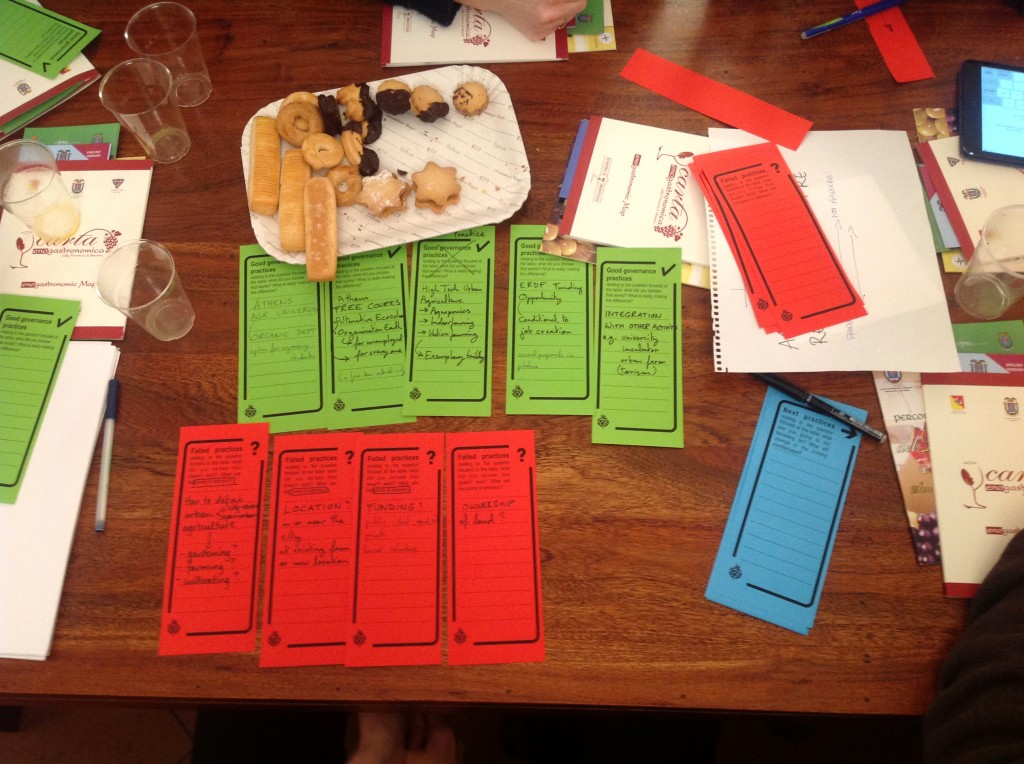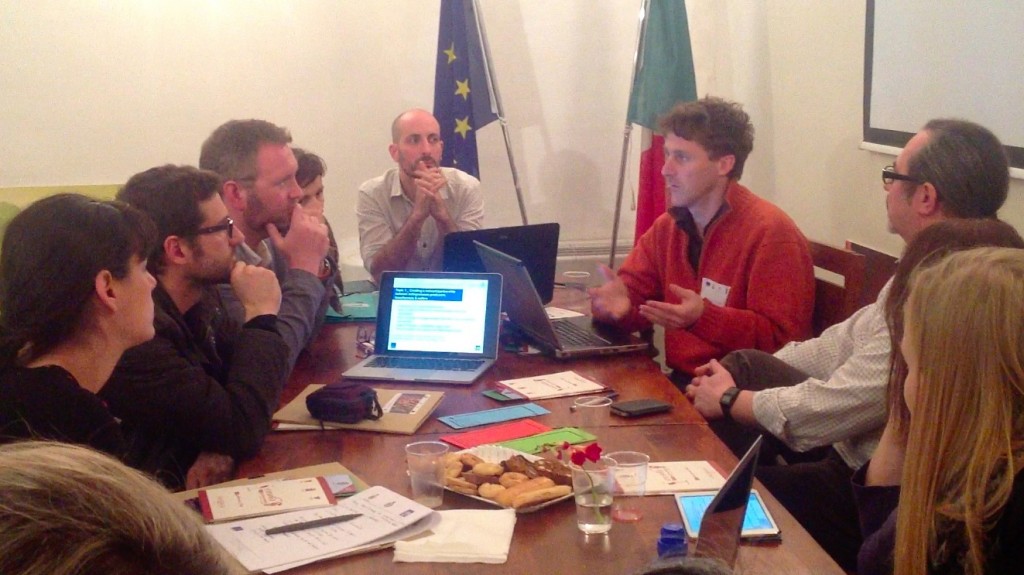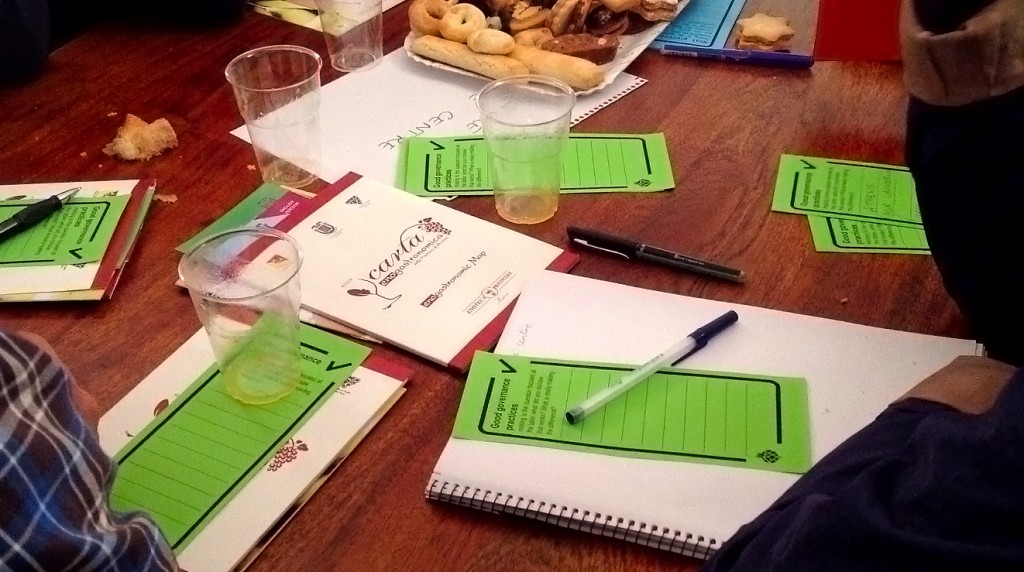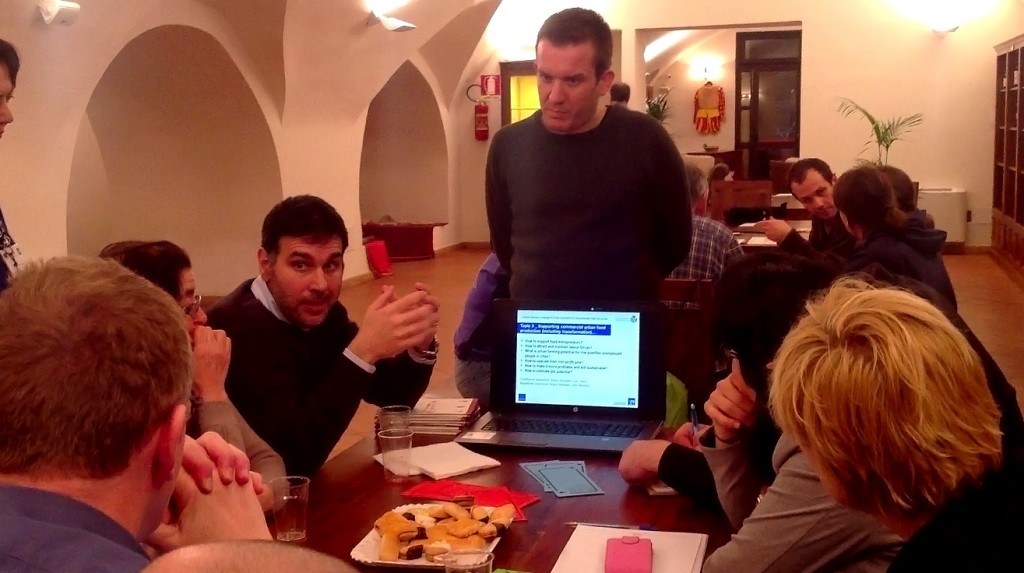Common opportunities and blocker in food production and preparation / Workshop
Opportunities or blockers/burning questions in food production and preparation common to subgroups of participants have been discussed in order to focus good practices, share ideas or creatively invent new solutions.
Workshop process:
- Common opportunities or blockers/burning questions have been predefined from the proposed list shared on the GoogleDoc and commented by the participating partners.
- 3 subgroups are formed in order to match as much as possible requests and offers of experiences/competences.
- Designation of a workshop moderator and a script rapporteur (both stays at the table).
- Discussions at tables are organized in 3 rounds sharing in pairs successively best governance practices, failed governance practices and next governance practices and discussing them.
- Presentations of the presentation by each team (videotaped).
- Deliverable: 1 page written synthesis following a predefined recommendations template per groups by the script rapporteur.
Table topic: Creating a network/partnership between entrepreneurs, producers, transformers & sellers
Reporter name: Rob Renaerts
Initial questions:
. How to start the network/partnership?
. How to shift from informal to more structures and formal partnerships?
. How to enlarge exchanges between alternative and conventional food worlds?
. How to articulate a sustainable supply chain?
. How to maintain and upscale the network/partnership?
Contributors: Amersfoort, Bristol, Brussels, Lyon, Vaslui
Requesters: Amersfoort, Göteborg, Lyon, Messina, Vaslui
Best practices
- Starting with an informal network and letting them find what they want to do together. This works but it is difficult to control the direction of the projects that are developed.
- Creation of a local currency (Bristol Pound and independents) which must be spend on local products or independent producers.
- Projects between local producers and school kitchens.
- Bringing consumers and producers together in a website to close the loop between offer and demand. The project is run by an NGO funded by the municipality. A similar project brought farmers and sellers together and facilitated deals confirmed by a notary act. Unfortunately the project came to a stop when the facilitator stopped.
- Facebook group for the MAJOBO project which created a lot of interest for the project and which has proven that online communication can work.
Failed practices
- Small networks are not working together but competing with each other. Need for an umbrella network and continued counselling to make them work together.
- Always the same products in food boxes for poor people. The government are not able to make supermarkets diversify the products they are donating.
- Making different small distributors working together failed because off mistrust between the partners and wanting to keep there own clients in stead off sharing them with the new structure. Similar problems emerged between organic and classic producers who could not be resolved. Another example of mistrust was seen by the lack off sharing information between microbrewers.
Promising practices
- Community supermarket where products of local producers can be sold. They also want to close the loop by giving the unsold products to food donation initiatives.
- Attracting new people and specialists in logistics who can get the project (which was on a dead end) moving again by working in small groups.
- Help for starting sustainable businesses like for instance organic poultry farm because there is a demand from consumers. It is not yet clear which type of support (financial, lighter administrative rules, etc.) is needed.
- Searching for funding for the animation of a network of sustainable actors.
- Working together with one partner and supporting the development of a test project. If the test is successful and the policy adopted, they will receive a lot of positive communication the other players in the market will follow. This turns the mistrust between the partners is an advantage.
- Making an action plan for urban agriculture and create a centre for urban agriculture which stimulates collaboration between de different organisations.
Policy recommendations
Step 1: Funding networking between the stakeholders without predetermined goals and not focus on the value for money. Collaborations cannot be pushed in a certain direction. It is better to let them evolve naturally.
Step 2: Judge the ideas coming from the networks and funds the best ideas according to the value for money principal.
Table topic: Urban agriculture centre, centres of excellence, exemplarity, demonstration, training…
Reporter name: Stephanie Mantell
Initial questions:
. How to concentrate knowledge and make it available?
. What are the different hypothesis of a ‘resources centre’?
. Which roles for universities and food/agriculture schools?
Requesters: Bristol, Brussels, Lyon, Oslo, Vaslui
Participants: Oslo, Brussels, Athens
Discussion of the current (best & failed) practices exchanged at the table
The discussion mainly focused on the range of possible of “Urban agriculture centres” and their specificities and points of attention.
Clarify “urban agriculture” terminology (and target audience)
Different partners use the term “urban agriculture” in different ways, for kitchen gardening, farming and cultivation in general…
Oslo refers to all food cultivation in the city, and in particular to small-scale gardening for own consumption that can be started by citizens as a recreational activity and to raise awareness.
Brussels focuses on professional commercial food growing activities in the city that can be carried out by farmers/entrepreneurs on plots of land or integrated in buildings.
In Athens were hardly any land is available for growing activities the focus would be on peri-urban commercial in soil farming or kitchen gardening.
Types of agriculture centres
Agriculture centres could take a wide range of forms depending on the objectives
- Integrated into a University or exemplary building for Research & Development for instance as a centre of excellence on high-tech urban agriculture techniques such as aquaponics, indoor farming, vertical farming…
- Integrated into an Agricultural University near the city for vocational training of agronomy students in in-soil farming, such as in Agricultural University of Athens were a specific department for organic agriculture was created.
- An incubator for entrepreneurs who start urban food growing businesses.
- Integrated into an urban farm that complements or redevelops its activities to include exemplary growing techniques, educational activities for kids, hobby gardeners and professionals…
- Information points to which individuals can turn to for guidance to learn about cultivation
- Community meeting centres that enable exchange of knowledge between citizens engaging in food cultivation in the city and possibly also with trainers, professionals or even researchers from University, such as the “hubs” now considered in Angered in Gothenburg, to encourage not only kitchen garden but also entrepreneurship.
Funding
Such activities can be publicly funded or privately funded with a commercial or non-commercial intent. Low cost voluntary projects are also possible carried out by associations/non-profit organisations, such as the Organisation Earth and Alternative Eco-school in Athens that target unemployed and everyone respectively. ERDF funding could be available to urban agriculture centres that focus on vocational training for job creation, and several such projects are currently considered in the Brussels Region.
Location
Depending on the purpose of the centre it could be located in the outskirts of the city were there is more available land in the city centre where it gets more visibility and accessibility for city dwellers or even decentralised in various neighbourhoods for maximum proximity. To develop such a centre and urban cultivation in general it is necessary to do a mapping to know where land is available and who owns it. Land owned by the city can be made available to such a centre and to growing activities.
Table topic: Supporting commercial urban food production (including transformation)
Moderator: Uxio Novoneira Rei
Reporter name: Cor Holtackers
Initial questions:
. How to support food entrepreneurs?
. How to attract and maintain labour forces?
. What is urban farming potential for low qualified unemployed people in cities?
. How to upscale from non-profit pilot?
. How to make it more profitable and still sustainable?
. How to estimate job potential?
Contributors: Amersfoort, Bristol, Brussels, Lyon, Vaslui
Requesters: Amersfoort, Bristol, Brussels, Lyon, Messina
Method of discussion:
First of all we had to agree on who are food entrepreneurs in the subject of growing: agreement on peri-urban farmers close to the city and urban farming.
We discussed on the questions following the suggestions on Good, Failed and Next practices on how to attract and maintain labour forces.
General conclusion:
Local food is not addressed to quantity but to quality of life, social inclusion, local job and employment issues, local environment improvement, resilience, transforming abandoned land, proudness of inhabitants in living in a vivid city, transparency of where the food comes from.
Good practices: key word is stimulation.
- Free spaces for land or market places on local produce or low pricing for producers for new market stalls with local produce.
- Small farmers helped by the government with money for improving their business and keeping them in business (Ourense)
- Vaslui dedicated selling areas for local growers in supermarkets.
- Upscale from non-profit: create added value by using clever marketing strategies for the products. Do not compete on the marketing of price with bulk production for the regular food business
Failed practices: competition with existing food chain.
Vaslui: due to open EU market qualified people in the agricultural business move to other countries for better wages, leaving behind a potential interesting opportunity for urban en peri urban farming.
General: Common agricultural growers who are situated in peri urban regions do not have interest in general for producing food for their own city or region. They are part of the present major food chain.
Next practices: local network and awareness keywords
Foster the cooperation of the local food growing food chain on every aspect from growing, delivering and marketing to make it more profitable? Make local food production and agriculture more sexy.
Messina: get clear figures on abandon land, land in use, unemployment figures, the average dimension of a typical regional farm and combine those result in a statistical and economical algorithm for more insight policy actions.



